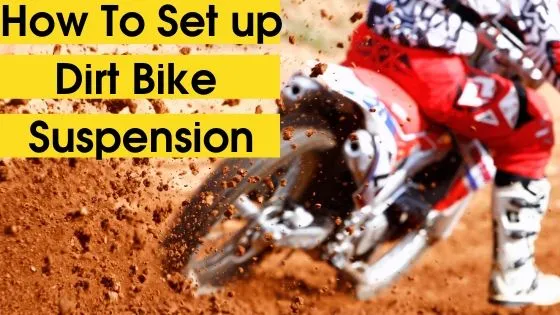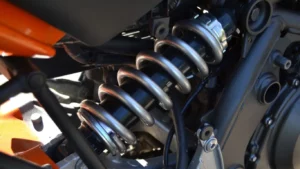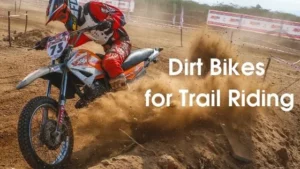Some riders are intimidated by adjusting and tuning their suspension. It’s not clear to us. But it’s not hard to fine-tune and set up your suspension if you know how it works. If you want to setup your dirt bike suspension, there are four important tips you should not miss.
Setting up the suspension isn’t difficult if you know your base setting from your owner’s manual.
Symptoms include tight dirt bike valves. Dirt bike Tight Valves: Symptoms must be identified for clarity. We have explained it in a separate article. If you want to get more detailed information on tight valves, then you should read our article on dirt bike tight valves symptoms.
So, read your owner’s manual, look at what you have, and consult others on the track. That’s a good tip for keeping your suspension ready.
What is Suspension On A Dirt Bike?
Off-road bikes need suspension. Suspension wasn’t invented until the 1970s, but it’s now standard on cars, trucks, and dirt bikes.
Suspension bikes allow riders to control the bike when cornering. Why do Suzuki dirt bikes corner so well?
The suspension allows the bike to “bounce” off the road instead of skidding like a dirt bike.
When riding for recreation or competition, the suspension must be set up correctly to maximize performance.
When riding an ATV, the suspension angle will be 45 degrees to the ground, but the front suspension will be set to the left for easier braking and turning.
Purpose of Suspension on a dirt bike
A dirt bike’s suspension makes riding more comfortable by allowing the rider to maintain control while leaned over.
Before installing suspension, the bike must be properly set up. Incorrect bike setup can damage the suspension beyond repair. Not all bikes have fully adjustable suspension.
First, ride your bike. Simply loosen the seat so you can stand and lean over the bike.
Manufacturers make different-sized modern suspension forks. Changing the forks for any reason other than changing the suspension will require new tires and possibly a new shock absorber.
If you want a bigger tire than your current one, you’ll need a new wheel or tire combo or a new front suspension fork.
When adjusting the forks, be careful not to break the front suspension mount.
A dirt bike’s suspension isn’t just for comfort. Any modifications to a dirt bike’s suspension can affect the ride quality.
Even if the bike has a suspension system, it must be set up properly. Valve clearance affects dirt bike performance. Loose or tight valve clearance affects performance.
How to set up dirt bike suspension?
Beginners must know how to set up dirt bike suspension. Broken suspension can cause serious bike damage.
First, don’t overwork the bike. If the bike stops suddenly when you let off the throttle, adjust the suspension. It needs some work.
If you’re on a level road, you don’t need to adjust, but if you’re going downhill, you do. Too-high or too-low suspension can damage your bike.
If your suspension doesn’t have a flat top or dual mount, install both at once. Both can be adjusted simultaneously.
Properly setting up your bike will improve your ride and speed. The settings should be closely monitored to avoid jumps.
Always keep new rear parts. Keeping things there will cause rust. This is something non-professionals should know.
Put the gas tank above the bike. Oil should go into the radiator above the bike.
Consider using professional air filters and hoses. Your bike’s connections are wrong.
If you don’t have the best open-air, riding will be difficult. Mastering this type of bike takes practice, but it’s possible. Here are the best 2 and 4 stroke dirt bike engine oils to boost performance.
Adjust air-filled tires. Dirt riding requires high air pressure. If you plan to ride your dirt bike often, you must set it up properly. That will prevent mistakes that could ruin your ride. Let’s go over the steps.
1. Front Compression
The compression adjuster is a screw on the fork. Counterclockwise softens, clockwise stiffens.
If you want a stiffer front suspension, turn it to the right until you hear a click; the opposite is true to soften it.
When riding and the shocks don’t give enough, adjust them. Turning counterclockwise softens them.
Too soft and your nose dives when braking, so tighten them. Whatever you do to one side, do to the other.
Unscrew them to release air, then re-screw them. Do this to both sides, and it’s recommended that you do this after every ride because the shock and fork will build up air, so if you want it to work properly, bleed your Forks.
2. Front Rebound
The rebound adjustment is at the bottom of the fork. See a screw that looks like the top one.
Rebound is how fast or slow a compressed shock will extend.
So if you can’t control a corner, you’re rebounding too fast.
To slow the rebound, turn the screw clockwise. This will make the ball bounce the opposite way, speeding up the rebound.
Both too fast and too slow can affect your handling, so you must experiment with your compression to find the sweet spot. Each side of your rebound must be the same.
3. Rear Compression
Your rear shock’s compression is low- and high-speed. Counterclockwise is low-speed. Turn clockwise to soften. They’ll stiffen it until low-speed clicks.
Turn counterclockwise to soften a quick adjustment. Tighten your quick change clockwise. This is how stiff your shock is when compressing slowly.
This affects rolling bumps.
4. Rear Rebound
Your court’s rebound will be adjusted similarly. Turning it H-wise slows your rebound and S-wise speeds it up.
Clockwise slows your rebound like Forks.
Basic Suspension Tips
1. Riding Position
Suspension isn’t always the problem. Positioning can cause problems. If you haven’t learned how to put your body weight in the right places at the right time, no suspension will work properly. Any body position imbalance affects suspension.
2. Alignment of Fork
Misaligned forks can damage your dirt bike. To align, torque the front end, air axle, triple tree bolts, and bike’s left side. Three times.
Third, check if your front fork tubes are lined while pressing in a brake, then torque our axle pinch bolts.
3. Adjusting your clickers
Turning the clicker clockwise adjusts it. Open the clicker to 10 and then rebound to 18.
You must count the clicks again after removing the screw. You must turn the clicker clockwise and open it 18.
4. Servicing your suspension
After 30 to 50 hours, it services your suspension. The oil develops polymers and stiction, which affects the bike’s performance. Changes compression and rebound damping. Why suspensions should be serviced every 30 to 50 hours.
What is Compression?
Forks compress and fully rebound. Forks compress when tires hit obstacles.
Forks fall after an obstacle is removed.
We convert tire energy in the forks into cartridge heat using the suspension.
Compression On A Dirt Bike?
Neglecting dirt bike compression. Dirt bike tire wear is important.
Tires are often worn poorly. Trail traction is essential. Unstable riders are doomed.
2-part tires. The tread stays intact. Compression removes or adds tread weight to create dirt bike traction.
Heavy, flat tires grip better than balanced tires. From where?
Compressing adds weight. Matching Weight maintains tire pressure.
Constant weight causes uneven tire compression. Consistent tire pressure is needed. Expanding tires maintain pressure. Why rotate tires:
Dirt bike seats aren’t backless. The bike’s back end will touch the ground. It raises the front.
Also affected is downhill cycling. Too-far-back tires can’t grip downhill.
The tire will hit bbs even when dropped. Bicycle drag slows it. You’ll crash.
Inflation prevents overloading. This is a dirt bike rule. Increase tire pressure by 1-2 pounds.
Ask an experienced dirt biker about tire pressure. Tire pressure checks can reduce gas costs.
Sunday night races may be higher if you blow a tire.
Tire-airbag. This helps maintain tire pressure, preventing bike theft.
It needs traction. Restriction. Change the tire if you overreach.
Understanding high and low compression
Going 70 mph through the desert and hitting whoops. It’s easy to hit. A slow shaft speed means a slow compression and rebound circuit.
You’re exiting a rut at 15 mph on a motocross track and hit a bottomless hole.
Due to high shaft speed, the shock will travel quickly. How to adjust high and low speeds is clearer.
Conclusion
As a beginner, you must understand dirt bike suspension. We’ve discussed how ignorance can damage your dirt bike. Here’s how to suspend your account. Please subscribe to our blog if you like the article.
Have Fun and Happy Riding






